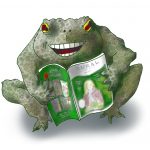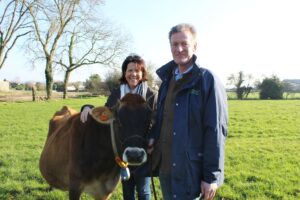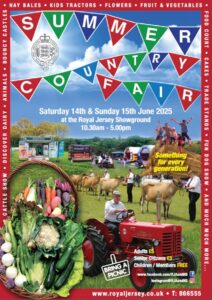We continue our series of articles in Jèrriais – Jersey’s own traditional native language.

The ‘frouque’ in question is a digging fork, rather than a table fork. An English translation follows.
This contribution comes from Wendy Middleton
DES OUAÎSIEAUX DANS LES FÔSSÉS
Eune matînnée întérêssante et tchi fait èrfliéchi, pâssée en compangnie d’ Cris Sellarés, Officyi d’ Projet pouor ‘Des ouaîsieaux dans les fôssés’, en prannant part dans eune marchéthie organnisée par la Société Jersiaise, avaû l’site proposé comme Rêsèrvâtion ès Ouaîsieaux d’ mé à Pliémont.
Même qué ch’ ‘tait raîqu’eune courte marchéthie d’pis les poffîns giants jusqu’à « Petit Becquet » et r’vénîn, j’fȗmes chanceurs dé vaie du mangnifique ouaîselîn, înclius un torsolé et un tas d’ grand’ néthes (ou « héthondes dé falaise ») au c’menchement d’ not’ pronm’nade, un coupl’ye de poffîns lus assiévant sus la mé, des blius poffîns, des cormouothans Ûropéens, des folle-mauves du Nord (et lus nids) et eune néthe mauve près d’ « Petit Becquet ».
Cris explyitchit qu’i’ y’a juste chent ans, i’ y’ avait deux chents ou trais chents pathes dé poffîns et un nombre similaithe dé blius poffîns et d’ dgillemots entre Pliémont et Grève dé Lecq. Achteu, les chiffres né sont pon bouôns viyant qu’ i’ y’ a raîque quat’ pathes dé poffîns et dgiêx pathes dé blius poffîns, tandis qu’les dgillemots dispathûtent compliétement d’ Jèrri i’ y’ a dans les dgiêx ans, et qué j’sommes à pèrdre les autres hardi quédaine.
Pouortchi qué j’sommes à pèrdre not’ ouaîselîn si rapidement?
L’ èrchèrche dans l’ pathage c’menchit en deux milles dgiêx-sept. I’ y’ a eune bouonne fournituthe dé nouôrrituthe auve un tas d’ lanchons (tchi sont des paîssons malgré lus nom!) et tchi sont eune èrsource împortante dé mangi pouor les ouaîsieaux d’ mé. La baie est même nommée ‘La baie des lanchons’ en Jèrriais! I’ y’ a un nombre dé m’niches pouor not’ ouaîselîn încliuant: les rats, les futhets sauvages, les cats et les hérissons. Dé ches’-chîn, les rats et les futhets sauvages sont la pus grosse m’niche, en mangeant les oeux, les jannes poulottes et les jannes poffîns (pufflings). I’ sont aîsis à attatchi car Cris trouvit quat’ fôsses dé futhets tout près d’la pliaiche ioù qu’un poffîn avait san nid.
Comme les poffîns ponnent raîqu’ un oeu par pathe et par l’an, la conséquenche dé tant d’ prédateurs si près d’ieux est qu’ autchun des jannes ouaîsieaux n’ peut laîssi l’île, à seule fîn d’y r’touônner pouor la saîson d’la ponnaîson au R’nouvé, car i’ sont tués d’vant dé tchitter. Viyant qu’les poffîns n’vivent qué pouor trente ans et qu’ i’ n’ peuvent brider qu’à l’âge dé quat’ ou chînq ans, il est êvident qué j’n’avons pon hardi d’ temps pouor lus aîdgi.
Don, tch’est qué j’pouvons faithe pouor aîdgi?
‘Des ouaîsieaux dans les fôssés’ sont à proposer d’ créer eune rêsèrvâtion ès ouaîsieaux d’ mé en embarrant un p’tit morcé d’ tèrre près d’ la mé. La cliôtuthe d’excliusion des prédateurs s’sait est un mille dé londgeu et deux mètres dé haut et ou s’sait pliaichie entre vîngt ou trente mètres en d’ssous du c’mîn d’pid sus la falaise. Les prédateurs non-natifs s’sont èrmués du pathage dé la rêsèrvâtion et la cliôtuthe a ‘té dessinnée pouor lus empêchi d’y entrer acouo eune fais.
À seule qué fîn qué j’piêssons vaie à tch’est qué ch’na s’en va r’semblier, eune petite dêmonstrâtion d’ la cliôtuthe s’sa înstallée dans un coupl’ye dé s’maines pouor qué les îlemans piêssent la visiter.
Des seurvais en lîngne s’sont lanchies, don, des commentaithes pouôrront êt’ faits d’vant qu’eune applyicâtion sait soumînse au départément d’ la pliann’nie. La cliôtuthe étha des hèches pouor l’accès du publyi en groupes, par exempl’ye, les pêtcheurs pouôrront aveindre lé bord. L’excliusion des prédateurs eut hardi d’succés dans pus d’ siêx chents îles, încliu Lundy, sus la côte Nord du Devon, où’est qu’ lé neunmétho d’ poffîns a creu dé sept à huit chents quarante-huit en seize ans.
Les manniéthes d’annimaux natifs dé not’ île né peuvent pon pâler pouor ieux-mêmes, et don j’tâchons d’ êt’ lus avocats. Cris nouos racontit qu’ un total dé trente-chîn manniéthes d’annimaux natifs, înclius des ouaîsieaux d’ mé, ofûche des manniéthes d’annimaux êteints comme les dgillemots, des reptiles comme les vèrtes lèzardes et des mammiféthes comme les mulots d’ Jérri, pouôrraient profiter d’ la créâtion d’un pathage protégi pouor eune rêsèrvâtion ès ouaîsieaux d’ mé. Don, seȗthement, la proposition ‘Des ouaîsieaux dans les fôssés’ s’sa un succés. J’ l’ espéthe si sîncéthement. Seulement l’ temps pouôrra l’ dithe…
Birds on the Edge…
An interesting and thought-provoking morning spent in the company of Cris Sellarés, Project Officer for Birds on the Edge, as part of a Société Jersiaise walk along the proposed site of the Seabird Reserve at Plémont.
Even though it was only a short walk from the giant puffins to Petit Becquet and back we were fortunate to see some magnificent birdlife including a kestrel and lots of swifts at the start of our walk, a couple of puffins sitting on the sea, some razorbills, European shags, Northern fulmars (and their nests) and a great black-backed gull near Petit Becquet.
Cris explained that just 100 years ago, there were some 200-300 pairs of puffins and a similar number of razorbills and guillemots between Plémont and Grève de Lecq. Now the figures aren’t looking so good, as there are only 4 pairs of puffins and 10 pairs of razorbills remaining with the guillemots having disappeared completely from Jersey around 10 years ago and we are fast losing the others.
So why are we losing our birdlife so quickly?
Research into this area has been ongoing since 2017. There is ample food with a plentiful supply of sand eels (which are fish despite their name!) and an important source of food for seabirds. The Bay is even called ‘The Bay of Sand Eels’ in Jèrriais! There are a number of threats to our birdlife including: rats, feral ferrets, cats and hedgehogs. Of these, rats and feral ferrets are the biggest threat, killing the young chicks and young puffins known as ‘pufflings’ and eating the eggs. They are easy targets as Cris has found 4 dens of ferrets close to one of the puffin nests.
As puffins only lay one egg per pair per year, the impact of so many predators close by is that no young birds are leaving the Island to then return for breeding season again in the Spring as they are being killed before they can leave. As puffins only live for 30 years and can breed from the age of 4 or 5 it is evident we have very little time to act to help them.
So what can we do to help?
Birds on the Edge are proposing to create a seabird reserve by fencing off a small amount of land close to the sea. The predator-exclusion fence would be one mile long and 2 metres tall and placed 20-30 metres below the cliff footpath. The non-native predators will be removed from the area of the reserve and the fence has been designed to prevent them from entering again. So we can see what it will look like, a small sample of the fence is being installed in a couple of weeks’ time for Islanders to visit. Online surveys will then be launched so comments can be made before an application is submitted to the planning department. The fence will have gates to allow public access for groups eg anglers so they are able to reach the shore. Removing predators has been successful in over 600 Islands including Lundy, off the coast of North Devon, where puffin numbers have increased from 7 to 848 in 16 years.
Our Island native species can’t speak for themselves so we must try to be their advocates. Cris told us that a total of 35 native species including seabirds possibly even extinct species like the guillemots, reptiles like green lizards and mammals like Jersey bank voles would benefit from the creation of a protected area for a seabird reserve so, surely, the Birds on the Edge proposal will succeed. I sincerely hope so. Only time will tell.




